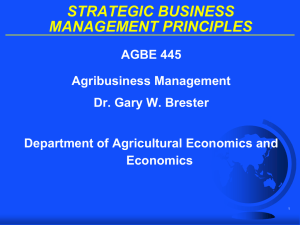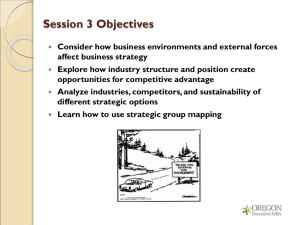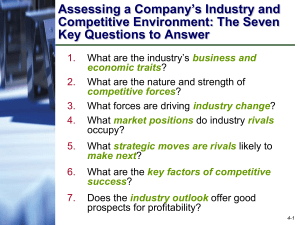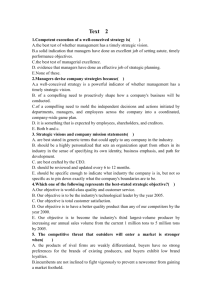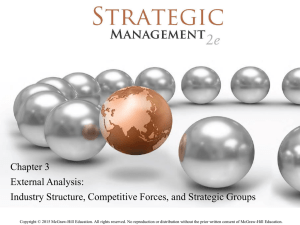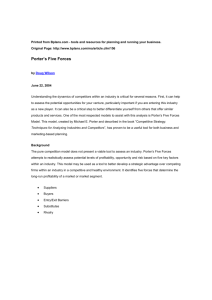Situation Analysis PowerPoint
advertisement
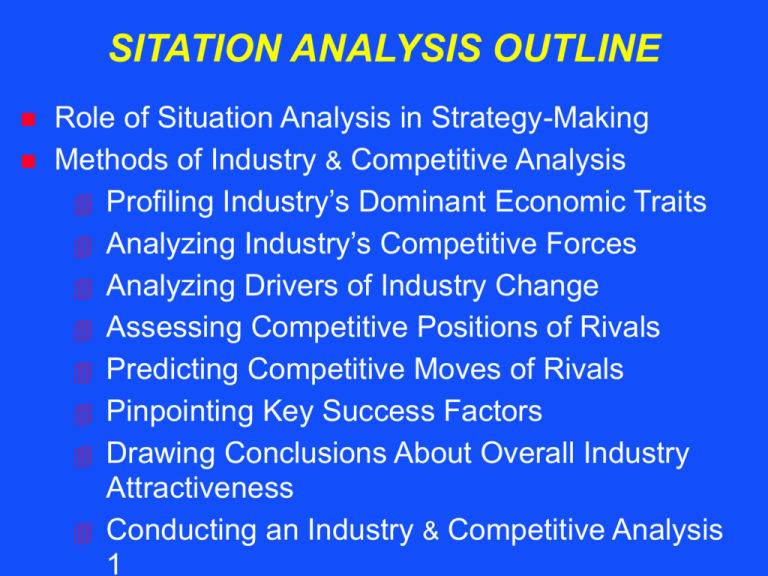
SITATION ANALYSIS OUTLINE Role of Situation Analysis in Strategy-Making Methods of Industry & Competitive Analysis Profiling Industry’s Dominant Economic Traits Analyzing Industry’s Competitive Forces Analyzing Drivers of Industry Change Assessing Competitive Positions of Rivals Predicting Competitive Moves of Rivals Pinpointing Key Success Factors Drawing Conclusions About Overall Industry Attractiveness Conducting an Industry & Competitive Analysis 1 WHY DO A SITUATION ANALYSIS? Identify features in a firm’s external & internal environment whichObjective frame its window of STRATEGIC OPTIONS OPPORTUNITIES Focuses on two considerations: EXTERNAL factors: MACRO environment (industry & competitive conditions) INTERNAL factors: MICRO environment (firm’s internal situation & competitive position) Figure 3-1: How Strategic Thinking and Analysis Lead to Good Choices Thinking Strategically About Industry and Competitive Conditions Identifying Strategic Options Open to the Company Thinking Strategically About a Company’s Own Situation Choice of The Best Strategy KEY QUESTIONS REGARDING EXTERNAL ENVIRONMENT 1. Industry’s dominant economic traits 2. Competitive forces at work in industry & strength 3. Drivers of change in industry 4. Firms in strongest/weakest competitive positions 5. Competitive moves of rivals 6. Key factors determining competitive success or failure in industry 7. Attractiveness of industry IDENTIFYING AN INDUSTRY’S DOMINANT ECONOMIC TRAITS Market size & growth rate/stage in life cycle Scope of competitive rivalry Number of competitors & relative sizes Prevalence of backward/forward integration Entry/exit barriers Nature & pace of technological change Product & customer characteristics Scale economies & experience curve effects Capacity utilization & capital requirements Industry profitability EXPERIENCE CURVE EFFECTS An experience curve exists when unit costs decline as cumulative production volume increases due to Increased KNOWLEDGE about or FAMILIARITY with the process The bigger the experience curve effect, the bigger the cost advantage of the firm with Largest CUMULATIVE production volume Figure 3-2: Comparison of Experience Curve Effects $1 Cost per Unit $1 90 80 81 70 64 72.9 51.2 49 34.3 10% Cost Reduction 20% Cost Reduction 30% Cost Reduction 1 2 Million Million Units Units 4 Million Units 8 Million Units EXPERIENCE CURVE EFFECTS Basic Concept When a strong learning/experience curve effect causes unit costs to decline substantially as cumulative production volume builds, a strategy to become the largest volume manufacturer can offer the COMPETITIVE ADVANTAGE of being the industry’s LOWEST-COST producer! ANALYSIS OF COMPETITIVE FORCES Objective To identify Main SOURCES of competitive forces and STRENGTH of these pressures COMPETITIVE FORCES MATTER BECAUSE: To be successful, strategy must be designed to cope effectively with competitive pressures objective must be to build a strong, market position based on competitive advantage! Figure 3-3: The Five Forces Model of Competition: A Key Analytical Tool Substitute Products Suppliers Rivalry Among Competing Sellers Potential New Entrants Buyers THE FIVE COMPETITIVE FORCES 1. RIVALRY among competing sellers in an industry 2. SUBSTITUTE PRODUCTS offered by firms in OTHER industries 3. Potential ENTRY of new competitors 4. Bargaining power of SUPPLIERS 5. Bargaining power of BUYERS PROCEDURE: ANALYZING THE FIVE COMPETITIVE FORCES Identify main sources of competitive pressures Rivalry among competitors Substitute products Potential entry Bargaining power of suppliers Bargaining power of buyers Assess strength of each competitive force Strong? Moderate? Weak? Scale of 1 - 5: 1 = weak; 5 = strong Explain how each competitive force works & its role in overall competitive picture RIVALRY AMONG COMPETING SELLERS Usually the MOST POWERFUL of the five competitive forces Weapons of COMPETITIVE RIVALRY Price Quality Performance features offered Customer service Warranties and guarantees Advertising & special promotions Dealer networks Product innovation PRINCIPLES OF COMPETITIVE RIVALRY A powerful competitive strategy launched by one firm INTENSIFIES competitive pressures on rivals! Use of various competitive weapons by rivals to out maneuver one another shapes Rules of competition & Requirements for competitive success PRINCIPLE OF COMPETITIVE MARKETS Competitive jockeying among rival firms is a dynamic process as Firms initiate new offensive & defensive moves Emphasis swings from one mix of competitive weapons to another WHAT CAUSES RIVALRY TO BE STRONGER? Lots of firms, equal in size and capability, exit Demand for product growing slowly Industry conditions tempt firms to use competitive weapons to boost volume Switching costs incurred by customers are low A firm initiates moves to bolster its standing at expense of rivals A successful strategic move carries a big payoff Costs more to get out of business than to stay in Firms have diverse strategies, corporate priorities, resources, & countries of origin COMPETITIVE FORCE OF POTENTIAL ENTRY New entrants boost competitive pressures By bringing new production capacity into play Through actions to build market share Seriousness of threat of entry depends on BARRIERS to entry Expected REACTION of existing firms to entry Barriers to entry exist WHEN It is difficult for newcomers to enter market A new entrant’s small sales volume puts it a price/cost disadvantage COMMON BARRIERS TO ENTRY Economies of scale Inability to gain access to specialized technology Existence of learning/experience curve effects Brand preferences and customer loyalty Capital requirements Cost disadvantages independent of size Access to distribution channels Regulatory policies Tariffs & international trade restrictions REACTION OF EXISTING FIRMS CAN BE AN ENTRY BARRIER WHEN existing firms Indicate they’ll aggressively defend their position Have substantial resources to wage defense Can use leverage with customers to keep their business THEN potential entrants likely to be discouraged by Prospects of a costly struggle Strong threat of competitive retaliation WHICH makes entry barriers HIGHER WHEN IS POTENTIAL ENTRY A STRONG COMPETITIVE FORCE? Competitive threat of outsiders entering a market is stronger when Entry barriers are low Incumbent firms do not vigorously fight newcomer Newcomer can expect to earn attractive profits COMPETITIVE FORCE OF SUBSTITUTE PRODUCTS Concept SUBSTITUTES matter when products of firms in another industry enter the market picture Examples Eyeglasses vs. Contact Lens Sugar vs. Artificial Sweeteners Plastic Containers vs. Glass vs. Tin vs. Aluminum Aspirin vs. Other Types of Pain Relievers WHY SUBSTITUTE PRODUCTS MATTER Competitively priced substitutes can place CEILING on PRICES industry can charge for its product Price ceiling can place LID on PROFITS industry members can earn Availability of substitutes invites customers to make QUALITY & PERFORMANCE comparisons as well as PRICE comparisons The lower the SWITCHING COSTS, easier it is for customers to shift to substitute products INDICATORS OF STRENGTH OF SUBSTITUTE PRODUCTS Growth rate of sales of substitutes Market inroads of substitutes Plan of manufacturers of substitutes to expand capacity Profits of firms producing substitutes PRINCIPLE OF COMPETITIVE MARKETS Competitive threat of substitute products is strong when Prices of substitutes are viewed attractive by buyers Buyers’ costs of switching to substitutes are low Buyers view substitutes as having equal or better performance features COMPETITIVE FORCE OF SUPPLIERS Suppliers are a strong competitive force when Item makes up large portion of costs of product, is crucial to production process, and/or significantly affects product quality It is costly for buyers to switch suppliers They have good reputations & growing demand for their product They can supply a component cheaper than industry members can make it themselves They do not have to contend with substitutes Buying firms are not important customers PRINCIPLE OF COMPETITIVE MARKETS Whether suppliers are a strong or weak competitive force depends on if they have bargaining power to put rivals at a competitive disadvantage based on: Prices they can command Quality & performance of items supplied Reliability of deliveries Other terms & conditions of supply COMPETITIVE FORCE OF BUYERS Buyers are a strong competitive force when They are large & purchase a sizable percentage of industry’s product They buy in volume quantities They incur low costs in switching to substitutes They have flexibility to purchase from several sellers Selling industry’s product is standardized They can integrate backward Product being purchased does NOT save buyer money or has low value to buyer PRINCIPLE OF COMPETITIVE MARKETS Buyers become a stronger competitive force the more they can exercise bargaining leverage over Price Quality Service Other terms & conditions of sale STRATEGIC IMPLICATIONS OF THE FIVE COMPETITIVE FORCES Competitive environment is unattractive when: Rivalry is very strong Entry barriers are low Competition from substitutes is strong Suppliers & customers have considerable bargaining power STRATEGIC IMPLICATIONS OF THE FIVE COMPETITIVE FORCES Competitive environment is ideal when: Rivalry is only moderate Entry barriers are relatively high There are no good substitutes Suppliers & customers are in a weak bargaining position Principle The weaker the competitive forces, the GREATER an industry’s PROFITS! COPING WITH THE FIVE COMPETITIVE FORCES Concept A company whose strategy and market position provide a GOOD DEFENSE against the five forces can earn aboveaverage profits even when some or all of the five forces are strong! COPING WITH THE FIVE COMPETITIVE FORCES Objective is to craft a strategy that will Insulate company from competitive forces Influence industry’s competitive rules in company’s favor Provide a strong position from which “to play the game” of competition Help create sustainable competitive advantage IDENTIFYING & ASSESSING DRIVING FORCES Concept Industry conditions change because EXTERNAL FORCES are DRIVING industry participants to alter their actions DRIVING FORCES are the MAJOR UNDERLYING CAUSES of changing industry & competitive conditions IDENTIFYING & ASSESSING DRIVING FORCES Role of driving forces analysis in strategy-making Indicates EXTERNAL FACTORS likely to have greatest impact on a firm over next 1 - 3 years Must assess difference driving forces will make to be able to craft a strategy responsive to emerging conditions DRIVING FORCES ANALYSIS Analysis of driving forces has two steps 1. Identifying RELEVANT driving forces 2. ASSESSING IMPACT they will have Task of driving forces analysis is: SEPARATE MAJOR causes of industry change from MINOR ones IDENTIFY the THREE or FOUR driving forces likely to have greatest impact on a firm over next 1 - 3 years TYPES OF DRIVING FORCES Changes in long-term industry growth rate Changes in who buys the product & how they use it Product innovation Technological change/process innovation Marketing innovation Entry or exit of major firms Diffusion of technical knowledge TYPES OF DRIVING FORCES Increasing globalization of industry Changes in cost and efficiency Shifting from standardized to differentiated products (or vice versa) Regulatory influences & government policy changes Changing societal concerns, attitudes, & lifestyles Changes in degree of uncertainty & risk ENVIRONMENTAL SCANNING Definition A broad-ranging effort to monitor & interpret social, political, economic, ecological, & technological events in an effort to spot budding trends & conditions that could eventually impact industry Purpose Raise consciousness of managers about potential developments that could Have important impact on industry conditions Pose new opportunities & threats ASSESSING COMPETITIVE POSITIONS: STRATEGIC GROUPS A STRATEGIC GROUP consists of those rival firms with similar competitive approaches & positions in an industry A STRATEGIC GROUP MAP displays different competitive positions that rival firms occupy STRATEGIC GROUP MAPS Firms in same strategic group have one or more competitive characteristics in common . . . Sell in same price/quality range Cover same geographic areas Be vertically integrated to same degree Have comparable product line breadth Emphasize same types of distribution channels Offer buyers similar services Use identical technological approaches COMPETITOR ANALYSIS A firm’s strategic moves are affected by Current strategies of competitors Actions competitors are likely to take next Profile of key competitors involves studying: Current position in industry Strategic objectives & recent actions Basic competitive approaches COMPETITOR ANALYSIS Successful strategists take great pains in scouting competitors by Understanding their strategies Watching their actions Evaluating their vulnerability to driving forces & competitive pressures Sizing up their strengths & weaknesses Trying to anticipate rivals’ next moves PREDICTING MOVES OF RIVAL COMPETITORS Predicting rivals’ next moves involves Analyzing current competitive positions Examining public pronouncements about what it will take to be successful in industry Gathering information from grapevine about current activities & potential changes Studying past actions & leadership Determining who has flexibility to make major strategic changes & who is locked into pursuing same basic strategy PRINCIPLE Managers who fail to study competitors closely risk being blindsided by “surprise” actions on the part of competitors! PINPOINTING INDUSTRY KEY SUCCESS FACTORS Basic Concept KEY SUCCESS FACTORS (KSFs) spell difference between Profit & loss Competitive success or failure A KEY SUCCESS FACTOR can be Specific skill or talent Competitive capability Something a firm must do to satisfy customers PINPOINTING INDUSTRY KEY SUCCESS FACTORS Identifying KSFs is top priority as they are good cornerstones of a firm’s strategy Winning COMPETITIVE ADVANTAGE often hinges on being distinctively better than rivals at one or more of the KSFs KSFs consist of the 3 - 5 really major determinants of financial & competitive success in industry EXAMPLE: INDUSTRY KEY SUCCESS FACTORS Beer/Brewing Industry Utilization of brewing capacity - to keep manufacturing costs low Developing a strong network of wholesale distributors - to gain access to retail outlets Clever advertising - to induce beer drinkers to buy a particular brand EXAMPLE: INDUSTRY KEY SUCCESS FACTORS Apparel Manufacturing Industry Fashion design - to create buyer appeal Low-cost manufacturing efficiency - to keep selling prices competitive EXAMPLE: INDUSTRY KEY SUCCESS FACTORS Tin & Aluminum Can Industry Locating plants close to end-use customers - to keep costs of shipping empty cans low Ability to market plant output within economical shipping distances STRATEGIC MANAGEMENT PRINCIPLE A sound strategy incorporates industry key success factors! CONCLUSION: OVERALL INDUSTRY ATTRACTIVENESS Objective To review overall situation & develop conclusions about relative attractiveness or unattractiveness of the industry, both near- and long-term Principle A firm uniquely well-suited in an otherwise unattractive industry can, under certain circumstances, still earn unusually good profits ASSESSING OVERALL INDUSTRY ATTRACTIVENESS Industry’s market size & growth potential Whether industry will be favorably or unfavorably impacted by driving forces Potential for entry/exit of major firms Stability/dependability of demand Will competitive forces become stronger or weaker Severity of problems facing industry Degree of risk & uncertainty in industry’s future Whether competitive conditions are conducive to rising/falling industry profitability CONDUCTING AN INDUSTRY & COMPETITIVE SITUATION ANALYSIS Two things to consider: 1. Task of analyzing a firm’s EXTERNAL situation cannot be reduced to a formula-like exercise 2. Sweeping industry & competitive analyses need to done every 1 to 3 years


